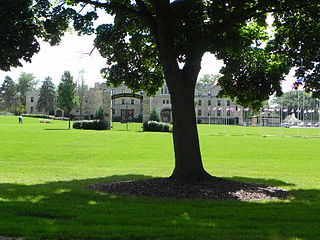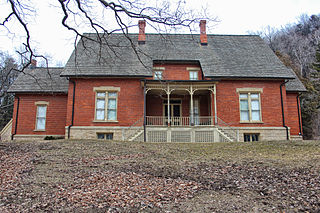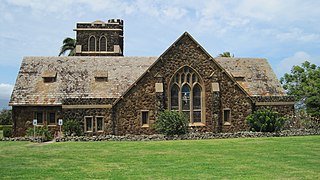
Aztalan State Park is a Wisconsin state park in the Town of Aztalan, Jefferson County. Established in 1952, it was designated a National Historic Landmark in 1964 and added to the National Register of Historic Places in 1966. The park covers 172 acres (70 ha) along the Crawfish River.

St. John's Northwestern Military Academy (SJNMA) was founded in 1884 as St. John's Military Academy (SJMA) in Delafield, Wisconsin, by Rev. Sidney T. Smythe as a private, college preparatory school. In 1995, Northwestern Military and Naval Academy (NMNA) in Lake Geneva, Wisconsin, merged with St. John's Military Academy to become St. John's Northwestern Military Academy on the Delafield campus. And, in 2020, a Leadership Academy was added and we became St. John's Northwestern Academies. SJNA is a coed independent boarding and day school for boys and girls in grades 7–12. St. John's Northwestern Summer Academy offers Little Lancers Day Camp, Summer OPS, and ESL courses.

Stonefield, located at 12195 County Road VV outside Cassville, Wisconsin, United States, was the 2,000-acre (800-hectare) estate of Wisconsin's first governor, Nelson Dewey. Much of the original estate has been separated into Nelson Dewey State Park and the Stonefield historic site, an expansive museum operated by the Wisconsin Historical Society. The historic site takes advantage of the large property by offering several different areas for visitors, including an early Wisconsin farmhouse, a re-created agricultural village built to resemble those common around 1900, and a reconstruction of Nelson Dewey's home. Stonefield is also home to the Wisconsin State Agricultural Museum, which features a large collection of antique farm equipment.

Forest Home Cemetery is a historic rural cemetery located in the Lincoln Village neighborhood of Milwaukee, Wisconsin and is the final resting place of many of the city's famed beer barons, politicians and social elite. Both the cemetery and its Landmark Chapel are listed on the National Register of Historic Places and were declared a Milwaukee Landmark in 1973.

Pendarvis is a historic site located in Mineral Point, Iowa County, Wisconsin, United States. The site, which is listed on the National Register of Historic Places, is made up of several 19th century cabins built by Cornish immigrants who came to Mineral Point to mine lead. Today the site is owned by the Wisconsin Historical Society and serves as a museum of Wisconsin's early lead mining history. Programs at the site also interpret the groundbreaking preservation work by Robert Neal and Edgar Hellum, begun during the Great Depression.

The American System-Built Homes were modest houses designed by architect Frank Lloyd Wright. They were developed between 1912 and 1916 to fulfill his interest in affordable housing. Wright was devoted to the idea of providing beautiful yet affordable homes to the public. His firm produced over 960 drawings for the project, the largest number of drawings for any project in the Wright archives. The designs were standardized, and customers could choose from seven models. Because of this standardization, the lumber could be precut at the factory, thereby cutting down on both waste and the amount of skilled labor needed for construction. The buildings are often termed prefabricated homes, but they were not, since no parts of the homes were constructed off-site. The lumber was cut at the factory, packaged along with all other components, and delivered to the work site for construction. Some are located in a federal historic district in Milwaukee, Wisconsin, and others have been designated Chicago Landmarks in Chicago, Illinois.

The Octagon House House Museum, also known as the John Moffat House, is a stucco octagonal house in Hudson, in the U.S. state of Wisconsin. The home was built in 1855 by John Moffatt and his wife, Nancy Bennet (1822-1894), who had moved to Hudson from Ithaca, New York the previous year with their ten-year-old daughter. Typical for the time, the Moffats traveled by train to Galena, Illinois where they took a steamboat to Prescott, Wisconsin. Then they traveled by horse and wagon, north to Hudson, which was a prosperous frontier town on the Saint Croix River, benefiting from lumber and flour mills. Two of Nancy's sisters already lived in the community when they arrived. Moffat initially was clerk of the United States Land Office for the Chippewa District and later practiced law before being elected a Saint Croix County judge in 1869. Their home is listed on the National Register of Historic Places.

Makawao Union Church is a church near Makawao on the Hawaiian island of Maui. It was founded by New England missionary Jonathan Smith Green during the Kingdom of Hawaii. The third historic structure used by the congregation was designed by noted local architect C.W. Dickey and dedicated in 1917 as the Henry Perrine Baldwin Memorial Church. In 1985, Makawao Union Church was placed on the Hawaii and National Register of Historic Places.

The Church Hill Historic District is a mid-to-upper-class residential area north of Portage's downtown. It was added to the National Register of Historic Places in 1997 for its significance in architecture and social history.

The Port Washington Downtown Historic District is the largely intact remainder of the old commercial downtown of Port Washington, Wisconsin, United States. It consists of about 40 contributing buildings built from the 1850s to the 1950s in various styles. The district was added to the National Register of Historic Places in 2000 for significance to both architecture and the history of commerce.

The Jacob Voigt House is a historic farm located in Mequon, Wisconsin, United States. It was added to the National Register of Historic Places in 2000.

The Benjamin Franklin Prescott House is a historic house on Prescott Street in Epping, New Hampshire. Built in 1875 for politician Benjamin Franklin Prescott, it is the town's finest example of Second Empire architecture. It was listed on the National Register of Historic Places in 1987.

The Smith's Corner Historic District is a historic district encompassing a historic 19th-century rural village center. Covering about 105.5 acres (42.7 ha), the district is centered on the junction of Main Avenue, South Road, and Chase Road in northwestern South Hampton, abutting its border with East Kingston. The village was important as a stagecoach stop. The district was listed on the National Register of Historic Places in 1983.

The 1855 Harris-Kearney House is an historical site located in Kansas City, Missouri, in the Westport neighborhood. Originally, the house was located at the intersection of modern-day Westport Road and Main Street The home is the oldest brick residence in the city.

The Daniel Pond Farmhouse, also known as Eggleston Farm, is a limestone-walled home built in Rutland, Wisconsin in the 1840s. In 1980 the house was listed on the National Register of Historic Places.

The Southwest Side Historic District is a neighborhood in Stoughton, Wisconsin with over 100 contributing properties in various styles built as early as 1856. It was added to the State and the National Register of Historic Places in 1997.

The Grove Street Historic District is a cluster of nine historic homes in various architectural styles built from 1910 to 1946 in Evansville, Wisconsin. It was added to the State Register of Historic Places in 2010 and to the National Register of Historic Places the following year.

















